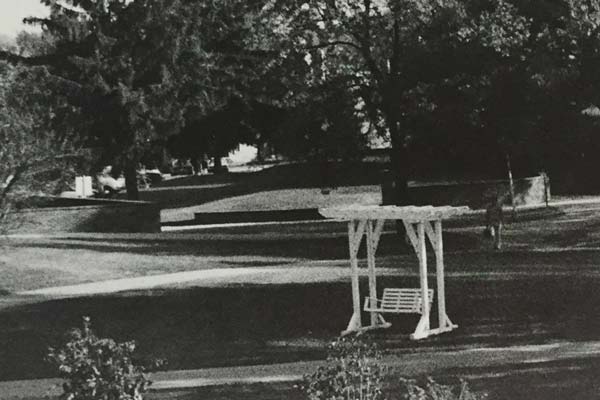Lipscomb’s three swings and a ring saying likely grew because there are so many swings on campus and so often passers-by see couples sitting on the swings.
The basic premise of “romantic” myth is that if a couple is spotted swinging three times, then the woman will get a ring. Sometimes love does spring from those swings, other times not.
“My brother and his girlfriend used to sit on the swings on campus all the time and they did get married,” 2010 grad Rachel Stevens said. “He even built a swing just like the one on campus in their backyard.”
Beaman Library Archivist Marie Byers added another detail to Lipscomb students’ pursuit of a college-romance-turned-lifelong-commitment.
Byers said before there were swings there were signature green benches all over campus which were known as “office spotlights.”
The benches were placed in very public areas to make sure modesty was a part of any heterosexual seating. The swings of love didn’t even arrive on campus until the spring of 1989, when students spied them upon returning from spring break.
The swings accompanied plans for some major buildings on campus. The new library, athletic facilities, an addition to Johnson Hall, more parking spaces and a new baseball field were all to begin construction that July.
To make room six run-down houses — they must have been, as students referred to them as “the ghetto” — were demolished. That neighborhood stood where the baseball field is now.
Ronnie Farris, head postmaster for The Connection, used to live in the old neighborhood that was displaced for the baseball field. He remembers having a picture of his son on a white swing at Lipscomb.
“It would be cool to get another picture of him now on the same swing from when he was a kid 20 years later,” Farris said, adding to his recollection of the first swing on campus in Bison Square.
Byers said a part of the tale is speculation that past president Harold Hazelip was inspired to bring the swings of love to campus.
 “Harold has ties to Harding University in Searcy, Ark., [where there are swings], and he also used to work at Harding’s graduate program in Memphis before he came to Lipscomb,” Byers said.
“Harold has ties to Harding University in Searcy, Ark., [where there are swings], and he also used to work at Harding’s graduate program in Memphis before he came to Lipscomb,” Byers said.
Wooden, bench swings were first designed and built at Harding by maintenance employee Harvey Dykes, father of the long-time Harding bookstore manager John Lee Dykes.
The swings were built soon after Harding moved from Morrilton to Searcy in 1934 — predating the swings on Lipscomb’s campus by almost 50 years.
“We were a little afraid to have swings because it was such a Harding thing,” said Sarah Keith Gamble, Associate Dean of Campus Life. “Eventually, it became silly to not have the swings just because another school had swings first.”
The squeaky sound of the swing and the old wooden benches perhaps are symbols of love, or at least hope for some Lipscomb students — at least those who believe the silly fable.

